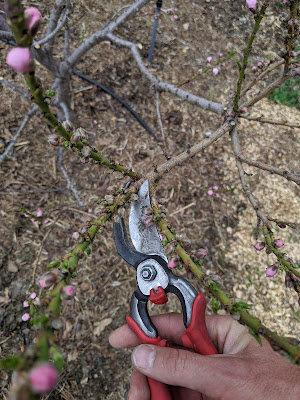Why I Don't Like Full Dwarf Fruit Trees
Fruit trees come in several different sizes. Standard, semi-dwarf and full dwarf trees are available to most gardeners, but full dwarf trees are probably my least favorite and this is why...
The root stock that a fruit tree is grafted to will determine the size of the tree. In other words, regular fruit tree scions are grafted to dwarfing root stock and the roots are limiting the growth of the tree.
Gardeners like dwarf trees because they stay small, need less pruning, and don't over grow the space in which they are planted. Sounds good right? Well what if your fruit tree is damaged or attacked by disease? Because these trees are less vigorous, they will not recover as quickly as a semi-dwarf or a standard sized tree.
Let me tell you a story that will help illustrate why I don't like full dwarf fruit trees. In the my community, there is a prominent building that was constructed. This edifice is supposed to be a highly aesthetic part of the city. For years the groundskeepers tried to get the lawn surrounding this beautiful building to grow and thrive, but it always looked patchy and uneven. It wasn't until they realized that the landscape architect spec'd a dwarf bluegrass variety that they realized why the lawn was always struggling. You see, if you have a dwarf lawn, it will never grow fast and full enough to get a good clean cut. The best lawns always look full, green, and evenly cut. A dwarf lawn will grow slow and any lack of nutrients or disease will further slow it's growth resulting in patchy, uneven, and discolored lawn that takes longer to recover.
If you would like more information about the care and pruning of fruit trees, Please subscribe here:
Like the lawn example above, dwarf fruit trees will slowly grow and slowly recover from disease. You will never be able to quickly manipulate or correct problems that arise.
But what if you want a small tree? You can have a small tree if you plant a semi-dwarf variety. With proper pruning techniques, you can decide how big you want your tree and you can maintain that tree at the exact same size for the entire life of the tree. If your tree becomes diseased, or if a limb breaks under heavy snow loads, your tree will quickly grow back and you can help your tree return to it's full productivity in just a few short years.
You might be saying, "but I don't want, or know how to prune my fruit trees, so I want to plant a dwarf variety that doesn't need as much pruning." The truth is, you still need to prune dwarf trees every year and because the nodes are so close together and dwarf trees are more susceptible to disease, I find them harder to prune. I can prune a small semi-dwarf tree faster than I can a full dwarf tree.
As you can see, I don't like full dwarf fruit trees and i don't think you can persuade me otherwise. If you disagree or have some insight that you would like to share regarding this topic, please comment below.
Thanks for reading! If you would like to learn more about the care and pruning of fruit trees, please browse our 100+ fruit tree articles here, join our Hobby Fruit Growers Facebook Group, and take our free Fruit Tree Pruning Course. Also, please subscribe to our Fruit Pruning YouTube Channel.







This is such a thoughtful perspective on dwarf fruit trees! I hadn’t considered how their slower growth and recovery could be a disadvantage, especially when it comes to disease or damage. The comparison to dwarf lawns is an interesting analogy that really drives the point home. For those of us with limited space, semi-dwarf trees seem like the perfect balance between manageable size and resilience. Does anyone have success stories or challenges to share about their experience with dwarf fruit trees? Would love to hear how others navigate these issues! 🍑🌳
ReplyDelete